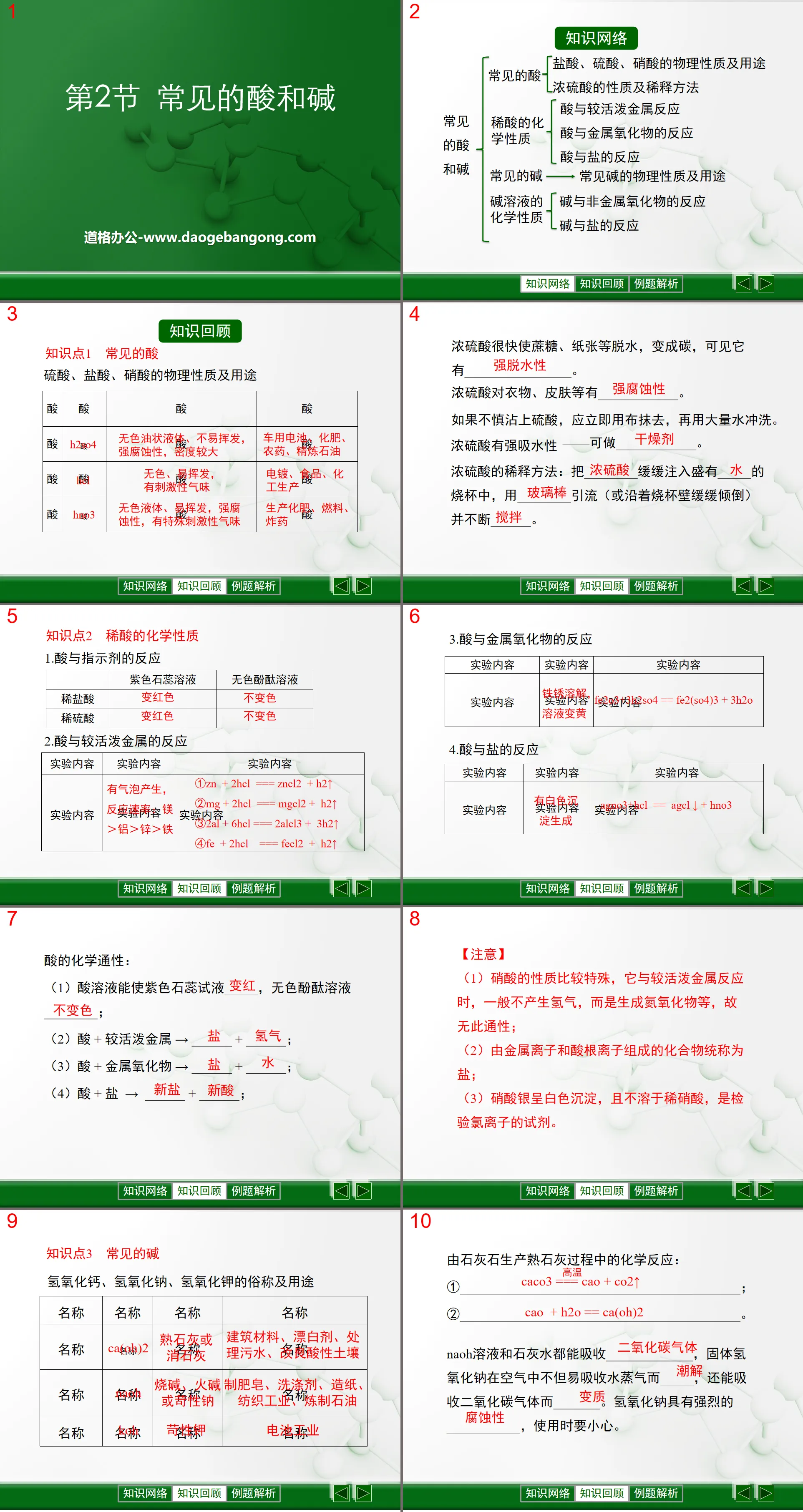People's Education Press High School Chemistry Compulsory Course I
Cantonese Education Edition Ninth Grade Chemistry Volume 1
Beijing Curriculum Reform Edition Ninth Grade Chemistry Volume 1
People's Education Press Ninth Grade Chemistry Volume 1
Beijing Curriculum Reform Edition Ninth Grade Chemistry Volume 2
Lu Jiao Edition Ninth Grade Chemistry Volume 1
Lu Ke Edition High School Chemistry Compulsory Course 1
Hunan Education Edition Ninth Grade Chemistry Volume 1
Cantonese Education Edition Ninth Grade Chemistry Volume 2
People's Education Press Ninth Grade Chemistry Volume 2
People's Education Press High School Chemistry Compulsory Course 2
Hunan Education Edition Ninth Grade Chemistry Volume 2
Lu Ke Edition High School Chemistry Compulsory Course 2
Lu Jiao Edition Ninth Grade Chemistry Volume 2

| Category | Format | Size |
|---|---|---|
| Cantonese Education Edition Ninth Grade Chemistry Volume 2 | pptx | 6 MB |
Description
"Common Acids and Bases" Common Acids, Bases and Salts PPT Courseware 5
knowledge network
Common acids and bases
Common acids
Physical properties and uses of hydrochloric acid, sulfuric acid, and nitric acid
Properties and dilution methods of concentrated sulfuric acid
chemical properties of dilute acids
Acids react with more reactive metals
Reaction of acids and metal oxides
reaction between acid and salt
Common bases→Physical properties and uses of common bases
Chemical properties of alkaline solutions
Reaction of bases with non-metal oxides
Reaction of base and salt
Knowledge review
Knowledge point 1 Common acids
Physical properties and uses of sulfuric acid, hydrochloric acid, and nitric acid
Sulfuric acid H2SO4
Colorless oily liquid, not volatile, highly corrosive, high density
Vehicle batteries, fertilizers, pesticides, refined petroleum
Hydrochloric acid HCl
Colorless, volatile, pungent odor
Electroplating, food, chemical production
Nitric acid HNO3
Colorless liquid, easily volatile, highly corrosive, with a special pungent odor
Production of fertilizers, fuels, and explosives
Knowledge point 2: Chemical properties of dilute acid
1. Reaction of acid and indicator
Purple litmus solution Colorless phenolphthalein solution
Dilute hydrochloric acid turns red but does not change color
Dilute sulfuric acid turns red but does not change color
2. Reaction of acid with more active metals
React magnesium, zinc, iron and aluminum with dilute hydrochloric acid respectively
Bubbles are generated, reaction rate: magnesium>aluminum>zinc>iron
chemical equation
①Zn + 2HCl === ZnCl2 + H2↑
②Mg + 2HCl === MgCl2 + H2↑
③2Al + 6HCl === 2AlCl3 + 3H2↑
④Fe + 2HCl === FeCl2 + H2↑
Chemical properties of acids:
(1) Acid solution can make purple litmus test solution _____ and colorless phenolphthalein solution _______;
(2) Acid + more active metal → ______ + ______;
(3) Acid + metal oxide → ______ + ______;
(4) Acid + salt → ______ + ______;
【Notice】
(1) The properties of nitric acid are quite special. When it reacts with more active metals, it generally does not produce hydrogen gas, but produces nitrogen oxides, etc., so it does not have this general property;
(2) Compounds composed of metal ions and acid ions are collectively called salts;
(3) Silver nitrate appears as a white precipitate and is insoluble in dilute nitric acid. It is a reagent for detecting chloride ions.
Example analysis
►Type 1: Dilution of concentrated sulfuric acid
Proposition perspective: Test students’ mastery of concentrated sulfuric acid dilution methods
Example 1 As shown in the figure is a schematic diagram of the experiment of diluting concentrated sulfuric acid.
(1) Write the names of the two instruments a and b in the picture on the right: a ________, b _______;
(2) The reagent contained in container b is ______ (fill in "water" or "concentrated sulfuric acid");
(3) During dilution, if the order of adding the two reagents is reversed, ____________ will occur;
(4) The role of the glass rod in the dilution process is _______________________.
[Analysis] (1) It can be seen from the figure that the instruments are: glass rod, measuring cylinder;
(2) When diluting concentrated sulfuric acid, the concentrated sulfuric acid is injected into the water;
(3) Since the density of water is smaller than that of concentrated sulfuric acid, and a large amount of heat is released when the two are mixed, injecting water into concentrated sulfuric acid will cause the water to boil and the liquid to splash out;
(4) Since concentrated sulfuric acid and water will release a lot of heat when mixed, a glass rod should be used to continuously stir the mixture to dissipate the heat in a timely manner.
►Type 2: Physical properties and uses of common acids
Proposition perspective: Test students’ mastery of the physical properties of common acids.
Example 2 Which of the following statements is correct ( )
A. Hydrochloric acid can turn purple litmus solution blue
B. When concentrated sulfuric acid is placed in the air, the solute mass fraction increases
C. The composition of solid sodium hydroxide does not change when exposed to air
D. When you open the reagent bottle of concentrated hydrochloric acid, white mist will appear at the mouth of the bottle.
[Analysis] A. Hydrochloric acid can turn purple litmus test solution red, so A is wrong; B. Concentrated sulfuric acid is exposed to the air. Due to its strong water absorption, the mass of the solvent increases, but the mass of the solute remains unchanged, so the mass fraction of the solute becomes smaller, so B is wrong; C. When solid sodium hydroxide is exposed to the air, it will absorb water and react with carbon dioxide in the air to form sodium carbonate, which will deteriorate, so C is wrong; D. Concentrated hydrochloric acid is highly volatile. When the cork is opened, a large amount of hydrogen chloride gas will volatilize, forming a white mist, so D is correct; therefore, choose: D.
►Type 3: Chemical properties of acids
Proposition perspective: Test students’ understanding of the chemical properties of dilute acids
Example 3 Formic acid (HCOOH) is a colorless liquid with a pungent odor and is highly corrosive.
(1) If it is proven that formic acid is acidic, the indicator that can be used is ____ (2) Formic acid has similar chemical properties to hydrochloric acid and can react with sodium carbonate to produce __________ gas.
(3) Utilize the dehydration property of concentrated sulfuric acid to mix and heat formic acid and concentrated sulfuric acid. When formic acid is dehydrated it will turn into ______________.
[Analysis] (1) If it is proved that formic acid is acidic, the indicator that can be used is purple litmus solution because purple litmus test solution turns red when exposed to acidic solution;
(2) Formic acid has similar chemical properties to hydrochloric acid and can react with sodium carbonate to produce carbon dioxide gas;
(3) Utilize the dehydration property of concentrated sulfuric acid to mix and heat formic acid and concentrated sulfuric acid. When a water molecule is removed from a formic acid molecule, it will be converted into carbon monoxide.
[Variation question] Hydrochloric acid or dilute sulfuric acid are often used as cleaning agents on metal surfaces by taking advantage of () their chemical properties.
A. Can react with alkali
B. Can react with metals
C. Can react with certain metal oxides
D. Can react with purple litmus test solution
【Analysis】
Metal surface cleaning is actually rust removal. It is actually a process in which acids and metal oxides react to form soluble salts. Therefore, acids have nothing to do with alkali, metals, and indicators. Only the reaction between acids and metal oxides is related to this process. .
So choose C.
Keywords: common acids and bases teaching courseware, common acids, bases and salts teaching courseware, Guangdong Education Edition ninth-grade chemistry PPT courseware download, second volume, ninth-grade chemistry slide courseware download, common acids and bases PPT courseware download, common Acid, alkali and salt PPT courseware download, .PPT format;
For more information about the PPT courseware "Common Acid, Base, Salts, Common Acids and Bases", please click on the Common Acids, Bases, Salts ppt, Common Acids and Bases ppt tab.
"Several Common Acids and Bases" Initial Acids, Bases and Salts PPT Courseware 3:
"Several Common Acids and Bases" Initial Acids, Bases and Salts PPT Courseware 3 1. Several common acids: 1. Physical properties of concentrated hydrochloric acid and concentrated sulfuric acid [Review Questions] 1. What are acids and bases? 2. What are the composition characteristics of acids and bases? Observe P11 experiments 1, 2, and 3 and complete the following...
"Several Common Acids and Bases" Initial Acids, Bases and Salts PPT Courseware 2:
"Several Common Acids and Bases" Initial Acids, Bases and Salts PPT Courseware 2 Preparation before class 1. Write the chemical formulas of common acids in life 2. Complete the following equations Mg Al Zn Fe; iron oxide, copper oxide and dilute respectively Chemical equation for the reaction of hydrochloric acid and dilute sulfuric acid. one..
"Several Common Acids and Bases" Initial Acids, Bases and Salts PPT Courseware:
"Several Common Acids and Bases" Initial Acids, Bases and Salts PPT Courseware Review before class 1. What kind of compound is called a base? Compounds in which all cations produced during ionization are H+ are called bases. 2. Which of the following compounds are bases? NaOH KOH Ca(OH)2 Ba(OH..
File Info
Update Time: 2024-10-02
This template belongs to Chemistry courseware Cantonese Education Edition Ninth Grade Chemistry Volume 2 industry PPT template
"Common Acids and Bases" Common Acids, Bases and Salts PPT Courseware 5 Simple campus recruitment activity planning plan summary enterprise and institution recruitment publicity lecture PPT template is a general PPT template for business post competition provided by the manuscript PPT, simple campus recruitment activity planning plan summary enterprise and institution recruitment promotion Lecture PPT template, you can edit and modify the text and pictures in the source file by downloading the source file. If you want more exquisite business PPT templates, you can come to grid resource. Doug resource PPT, massive PPT template slide material download, we only make high-quality PPT templates!
Tips: If you open the template and feel that it is not suitable for all your needs, you can search for related content "Common Acids and Bases" Common Acids, Bases and Salts PPT Courseware 5 is enough.
How to use the Windows system template
Directly decompress the file and use it with office or wps
How to use the Mac system template
Directly decompress the file and use it Office or wps can be used
Related reading
For more detailed PPT-related tutorials and font tutorials, you can view: Click to see
How to create a high-quality technological sense PPT? 4 ways to share the bottom of the box
Notice
Do not download in WeChat, Zhihu, QQ, built-in browsers, please use mobile browsers to download! If you are a mobile phone user, please download it on your computer!
1. The manuscript PPT is only for study and reference, please delete it 24 hours after downloading.
2. If the resource involves your legitimate rights and interests, delete it immediately.
3. Contact information: service@daogebangong.com
"Common Acids and Bases" Common Acids, Bases and Salts PPT Courseware 5, due to usage restrictions, it is only for personal study and reference use. For commercial use, please go to the relevant official website for authorization.
(Personal non-commercial use refers to the use of this font to complete the display of personal works, including but not limited to the design of personal papers, resumes, etc.)
Preview










